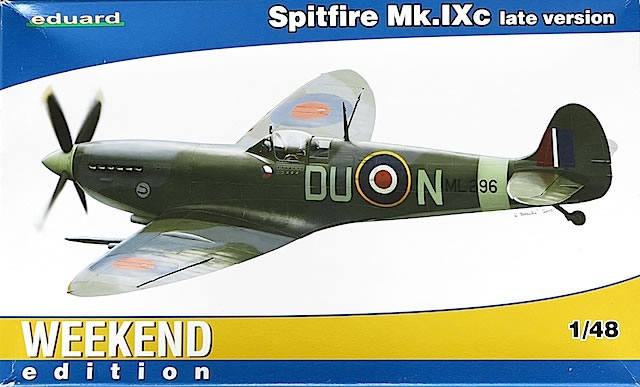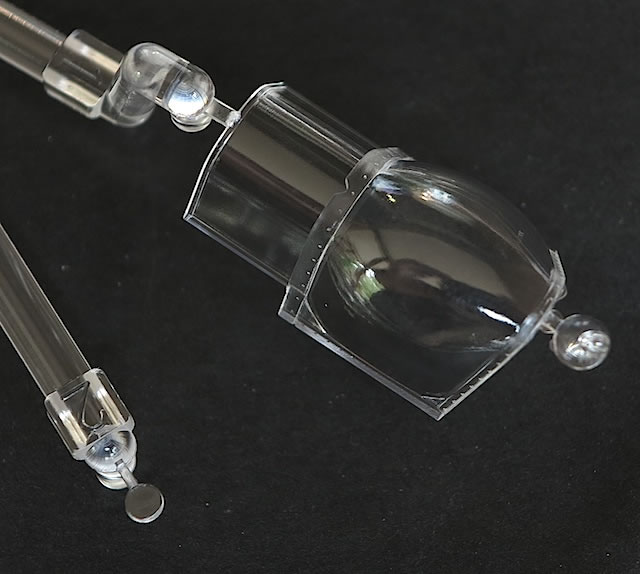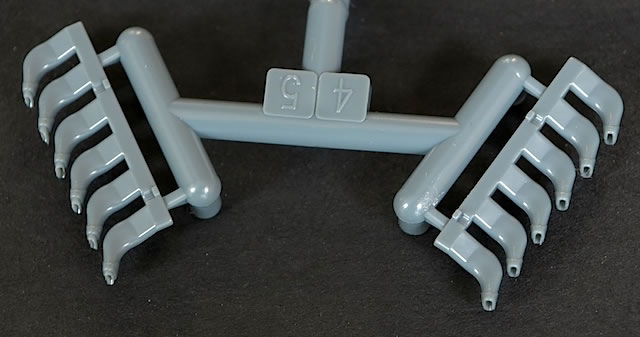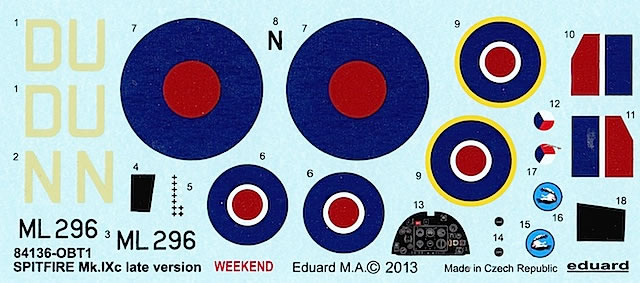|
Spitfire Mk.IXc Late Version
Weekend Edition

Eduard, 1/48 scale
S
u m m a r y |
| Catalogue Number: |
Eduard Kit No. 84136 – Spitfire Mk.IXc late version Weekend Edition |
| Scale: |
1/48 |
| Contents and Media: |
Approximately 183 grey plastic parts (57 unused); 14 clear plastic parts (6 unused); 1 decal sheet containing markings for 1 aircraft; 12 page black and white instruction booklet |
| Price: |
USD$25.46 plus shipping available online from Eduard’s website |
| Review Type: |
FirstLook |
| Advantages: |
Accurate and well-engineered kit; high quality plastic parts with excellent detail; interesting marking option; good instructions and decals. |
| Disadvantages: |
Flare rack on seat should be omitted. |
| Conclusion: |
Eduard’s Spitfire Mk.IXs are the best 1/48 scale Spitfire kits produced to date, and it’s good to have one available in Weekend Edition format. The level of detail is excellent, even without the photo-etched parts that are standard in Profipack boxings, and the marking option is a worthy choice. Highly recommended to all Spitfire modellers, but particularly those who have yet to savour this very good kit. |
Reviewed by Brad Fallen

Eduard's 1/48 scale Spitfire Mk.IXc Late Version Weekend Edition
is available online from Squadron.com
The Spitfire Mk.IX was manufactured between 1942 and 1945, and with nearly 5,700 built was only surpassed by the Mk.V as the most produced Spitfire variant. The rapid pace of wartime development saw the Mk.IX design tweaked many times during production, with the final clipped wing, pointed rudder, bubbletop machines looking very different to the initial Mk.V conversions. Most differences between Mk.IXs were subtler than this, though, and when you are modelling a specific aircraft it pays to consult your references closely to make sure you are capturing the right details. A good source for getting to grips with some of these differences is the Spitfire Site’s chapter entitled “Spitfire Mk.IX, XI and XVI – variants much varied”.
Eduard has tooled its 1/48 Spitfire Mk.IX sprues so that, with the right combination of parts, modellers can build an aircraft from almost anywhere in the type’s production run. The first kit released was a Mk.IXc late version (Profipack boxing) in April 2013, followed three months later by a Royal Class boxing with parts for two kits that could be built as a combination of early IXc, late IXc, early IXe or late IXe. In November 2013 Eduard released a dedicated Mk.IXc early version Profipack, and in February 2014 also released a Mk.IXe Profipack kit.
Sandwiched between these two releases is Eduard’s first Weekend Edition Spitfire boxing, which revisits last year’s series launch with a Mk.IXc late version.
The kit comes in Eduard’s usual Weekend Edition packaging with attractive box art of the single marking choice – ML296/DU-N flown by F/LT Otto Smik, CO of B Flight, No.312 (Czechoslovak) Squadron, based at RAF North Weald in August 1944. The box serves as a colour guide for painting and marking, with small four view drawings of ML296 on the sides and ends in addition to the main painting.
Inside, the box is surprisingly full for a kit that contains none of the Profipack extras such as photo-etched and Brassin details, canopy masks or multiple marking options. This is partly because Eduard takes a different approach to some other kit manufacturers and doesn’t hold back parts for versions that aren’t included in the current boxing. As a result, there are lots of extras for the spares box – by my count, just under one-third of the kit’s nearly 200 pieces. These surplus bits include cowlings, elevators, horizontal stabilisers, clipped wing tips, gear legs and covers, wheels, cannon fairings, carburetor intakes, bombs and some internal details. This means that if you’re tempted to build an aircraft other than ML296, you’ll have many of your options covered – although you’ll need to restrict your choice to a Mk.IXc, because (not unreasonably) an ‘E’ wing isn’t provided.
The high quality of Eduard’s Spitfire Mk.IX plastic parts has been mentioned in a number of previous reviews on Hyperscale, and – without going into unnecessary repetition – I’ll do the same here. The very fine surface detail looks even better at second glance, and with the moulds still new there is no flash or imperfections on the parts. Brett Green has commented favourably on the kit’s buildability here – and Brett’s build includes several aftermarket Brassin sets, which means that construction of the plastic-only Weekend Edition kit should be even more straightforward.

Particularly worth mentioning is the level of the detail in the cockpit, which makes up from nearly 40 parts and is a far cry from the stock cockpits of most other 1/48 Spitfire kits. As always, however, I’d recommend you drape some photo-etched harnesses over the seat, especially if you are finishing your model with the canopy open. A decal is supplied to represent the instrument panel, in the absence of the photo-etched item in Profipack boxings.
The hollowed-out exhausts, underwing radiators and wheel wells are also noteworthy, notwithstanding the latter’s multi-part engineering and slightly fiddly construction. Less positively, the carburetor intake has been moulded in two halves integrally with the lower cowling, which when joined will result in a difficult to reach seam inside the intake.

The instructions cover 12 black and white A4 pages and appear to be quite user-friendly, with assembly illustrations presented clearly and in a logical sequence. Scrap drawings provide guidance in relation to the correct ‘sit’ of the undercarriage, and modellers are invited to choose between early or late styles of rudder, with Eduard noting that photos of ML296 are inconclusive on this matter.
Markings
As is frequently the case with Weekend Edition kits, the marking option has been taken from an earlier Eduard release – in this case last year’s Mk.IX late version Profipack. ML296 is a good marking choice because it is simultaneously interesting and representative. It’s interesting because of Smik’s colourful but ultimately tragic wartime experiences, and representative because ML296 was finished in typical European theatre camouflage of Dark Green and Ocean Grey over Medium Sea Grey, with Sky spinner, fuselage band and codes. The simplicity of this colour scheme makes the four view, black and white painting and marking guide perfectly adequate – and if you want to see a colour version of the guide then a link is provided.

The decals have been produced by Eduard and are printed on a single small sheet. Everything appears to be in register, including the four-colour fuselage roundels, although the blue in all of the roundels might benefit from a slight darkening during the weathering process. The other colours look good, though, and I especially like the subtle difference in the shades of red used in the RAF roundels and the small Czech insignia beneath the cockpit. No stencils are provided, with Eduard now selling these sheets separately to those modellers who want them.
Eduard’s Spitfire Mk.IXs are the best 1/48 scale Spitfire kits produced to date, and it’s good to have one available in Weekend Edition format. The level of detail in the kit is excellent, even without the photo-etched parts that are standard in Profipack boxings, and the marking option is a worthy choice. Highly recommended to all Spitfire modellers, but particularly those who have yet to savour this very good kit.
Thanks to Eduard for the review sample.
References
Robert Humphreys, ‘The Supermarine Spitfire – A Comprehensive Guide for the Modeller, Part 1: Merlin Powered’ (SAM Publications, 2000)
Alfred Price, ‘Spitfire in Combat’ (Sutton Publishing, 2003)
www.spitfiresite.com
Thanks to Eduard for the sample
Review Text Copyright © 2014 by Brad Fallen
Page Created 25 February, 2014
Last updated
25 February, 2014
Back to HyperScale Main Page
Back to Reviews Page |
